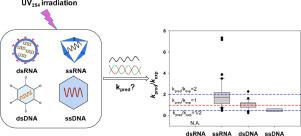Water Research ( IF 12.8 ) Pub Date : 2021-04-21 , DOI: 10.1016/j.watres.2021.117165 Shuangshuang Cheng , Yuexian Ge , Yunho Lee , Xin Yang

|
UV254 irradiation disinfection is a commonly used method to inactivate pathogenic viruses in water and wastewater treatment. Model prediction method can serve as a pre-screening tool to quickly estimate the effectiveness of UV254 irradiation on emerging or unculturable viruses. In this study, an improved prediction model was applied to estimate UV254 photolysis kinetics of viral genomes (kpred, genome) based on the genome sequences and their photoreactivity and to correlate with the experimental virus infectivity loss kinetics (kexp, infectivity). The UV254 inactivation data of 102 viruses (including 2 dsRNA, 65 ssRNA, 33 dsDNA and 2 ssDNA viruses) were collected from the published experimental data with kexp, infectivity ranging from 0.016 to 3.49 cm2 mJ−1. The model had fairly good performance in predicting the virus susceptibility to UV254 irradiation except dsRNA viruses (Pearson’s correlation coefficient = 0.64) and 70% of kpred, genome fell in the range of 1/2 to 2 times of kexp, infectivity. The positive deviation of the model often occurred for photoresistant viruses with low kexp, infectivity less than 0.20 cm2 mJ−1 (e.g., Adenovirus, Papovaviridae and Retroviridae). We also applied this model to predict the UV254 inactivation rate of SARS-CoV-2 (kpred, genome = 3.168 cm2 mJ−1) and a UV dose of 3 mJ cm−2 seemed to be able to achieve a 2-log removal by conservative calculation using 1/2kpred, genome value. This prediction method can be used as a prescreening tool to assess the effectiveness of UV254 irradiation for emerging/unculturable viruses in water or wastewater treatment.
中文翻译:

紫外线254辐照下病毒基因组的光解动力学预测,以估计病毒的感染力损失
UV 254辐射消毒是在水和废水处理中灭活病原病毒的常用方法。模型预测方法可以用作预筛选工具,以快速估计UV 254照射对正在出现的或无法培养的病毒的有效性。在这项研究中,基于基因组序列及其光反应性,使用一种改进的预测模型来估计病毒基因组(k pred,基因组)的UV 254光解动力学,并与实验性病毒传染性丧失动力学(k exp,传染性)相关联。紫外线254从已发表的实验数据中收集了102种病毒(包括2个dsRNA,65 ssRNA,33 dsDNA和2 ssDNA病毒)的失活数据,其k exp的感染力范围为0.016至3.49 cm 2 mJ -1。除了dsRNA病毒(Pearson相关系数= 0.64)和k pred的70%外,该模型在预测病毒对UV 254辐射的敏感性方面具有相当好的性能,基因组落在k exp感染力的1/2至2倍范围内。该模型的正偏差经常发生在k值低,传染性小于0.20 cm 2 mJ的光抗性病毒中-1(例如,腺病毒,巴氏病毒科和逆转录病毒科)。我们还应用了该模型来预测SARS-CoV-2的UV 254灭活率(k pred,基因组 = 3.168 cm 2 mJ -1)和3 mJ cm -2的UV剂量似乎能够达到2-通过保守计算,使用1/2 k pred,基因组值进行对数去除。该预测方法可以用作预筛选工具,以评估UV 254辐射对水或废水处理中新兴/不可培养病毒的有效性。



























 京公网安备 11010802027423号
京公网安备 11010802027423号